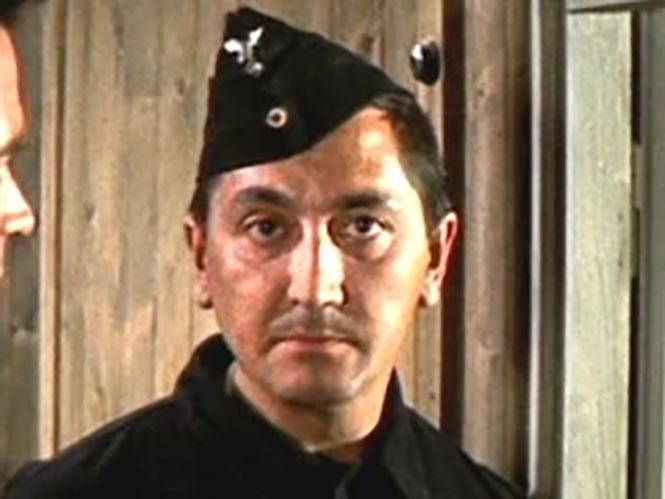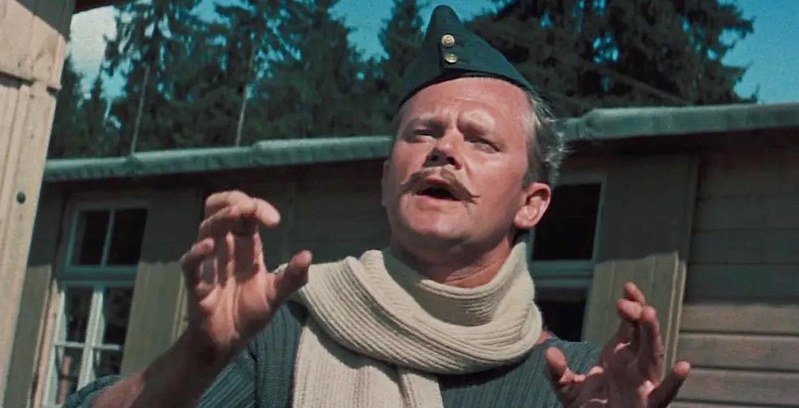'The Great Escape': 10 little-known historical curiosities about that excellent movie
In 1963, an excellent film about Allied prisoners of World War II was released, based on true events - "The Great Escape".
This film had a luxury cast and a fantastic soundtrack composed by Elmer Bernstein. Although the facts he shows differ in certain points from the real ones (and he added things that did not happen, such as the escapes on a motorcycle and on a plane), there are certain very striking historical details surrounding the film, which they have surely been ignored for many years by many who have seen it. Below we are going to review some of those details, which undoubtedly encourage us to value this great cinematographic work even more.

1. Donald Pleasence, a real british prisoner
A rare thing when making a movie about prisoners of war is that one of them would have been a prisoner of war. It was the case of the English actor Donald Pleasence, who plays the forger who is losing his sight. his story is very curious. He was raised in a Methodist Christian family and at the start of the war he registered as a conscientious objector to refuse to enlist. He changed his mind in 1940, after the brutal German bombing campaign against the UK, the famous "Blitz". Then Pleasence enlisted as a volunteer in the RAF (the British Royal Air Force), serving in the 166th Squadron of Bomber Command, participating in almost sixty sorties (a very high number: in American bombers, they considered good luck reaching the 25th mission alive).
On August 31, 1944, his Avro Lancaster bomber was shot down over Agenville in northern France. He parachuted and was captured by the Germans, being sent to the Stalag Luft I prison camp, in northeastern Germany (the camp in the film was Stalag Luft III and was located in the west of present-day Poland). Pleasence had already started his acting career shortly before the outbreak of the war, so during his captivity he dedicated himself to organizing and acting in plays to entertain his companions.

2. Hannes Messemer, the German commander who was a prisoner of war
Pleasence wasn't the only ex-POW in the cast. In the film, German actor Hannes Messemer played Colonel Von Luger, the commander of the Luftwaffe prison camp. In real life, Messemer fought on the Russian front, was captured by the Soviets and managed to escape after the war , returning to his home on foot. He was 39 years old when the film was made, but the actual camp commander, Friedrich Wilhelm von Lindeiner-Wildau, was a World War I veteran and was 61 when he was given command of the Stalag Luft III. Von Lindeiner-Wildau had no Nazi sympathies, he earned the prisoners' respect for his good treatment of them , and after the war he helped build a monument to the 50 murdered prisoners.

3. Til Kiwe, a former German prisoner who tried to escape 17 times
Another actor from "The Great Escape" who experienced captivity during the war was the German Til Kiwe, who plays Frick, the German sentry who discovers the escape. His real name was Jan Heinrich Tilman kiwe. In real life, Kiwe began his studies as an actor before World War II. After the war began, he fought with the Wehrmatch in North Africa, reaching the rank of captain and receiving the Knight's Cross of the Iron Cross on May 18, 1943. In his case , was captured by the Americans and sent to an Arizona prison camp. Although he was far from his country and in the middle of a desert, he did the same as the allied prisoners in the film: he starred in 17 escape attempts, with the purpose of reaching California and, once there, , return to the war zone. After the war, he began his acting career in 1946.

4. Richard Attenborough, the Big X who filmed the war from a bomber
This English actor played the role of a British officer known as the Big X, the head of the Allied prisoner organization dedicated to organizing escapes. In real life, Attenborough was 16 years old when the war broke out. His family took in two German-Jewish girls, Helga and Irene Bejach, ages 9 and 11, respectively. Both were adopted by the Attenboroughs at the end of the war, when they discovered their parents had been killed by the Nazis. Like Pleasence, Attenborough enlisted in the RAF during the war and also flew bombers, rising to the rank of sergeant, but in his case as part of the RAF Film Production Unit, filming with his camera several British sorties from the dangerous position of the tail gunner.

5. Hans Reiser, another ex-prisoner in the role of a member of the Gestapo
Also among the German cast members was Hans Reiser, who plays a Gestapo officer. At the beginning of the film he threatens Bartlett in case he is recaptured. In real life, he began his professional career as a stage actor in 1936, appearing in the German film "Die See ruft" (1941). In World War II he served as a soldier and was captured by the Americans. After his captivity, he resumed his film career, participating in dozens of films until his death in 1992.

6. Charles Bronson, the tunnel digger who really had claustrophobia
One of the stars of the cast of "The Great Escape" was the American actor of Lithuanian origin Charles Bronson. Raised in a Catholic family of Tatar origin, in the film he plays the role of a Polish airman who had managed to make it to the United Kingdom to enlist in the RAF, something very frequent during the war (in fact, 16 Polish squadrons were formed in the Royal Air Force, and one of them, 303rd Squadron, was the most successful during the Battle of Britain). In the film, Bronson plays a tunnel digger and is claustrophobic. The fact is that he actually had it , after having worked in a coal mine. Although in the film he is one of the three prisoners who complete their escape (along with one British and one Australian), in reality the three prisoners who managed to escape were two Norwegians and one Dutchman.

7. Robert Graf, the German soldier who was sent to the Russian front
One of the German actors who participated in the film was Robert Graf. he plays the role of a Luftwaffe soldier whose documentation is taken away . One of his dialogues includes a reference to the Germans' fear of being sent to the Russian front as punishment. He knew what he was talking about: in real life, at only 18 years old he was called up by the Wehrmacht and sent to Russia, being wounded in 1944. Ironically, that fact opened the path that led him to would lead him to participate in "The Great Escape": assigned to an arms factory in Munich, where he began his theater studies, beginning his professional career as an actor in 1946. He did not manage to capitalize on the great fame that gave him this film: he died of cancer on February 4, 1966. By the way, his role in the film concealed a historical fact: the prisoners got German documentation thanks to Nazi-hating Luftwaffe sentinels, as well as thanks to the help of German civilians from abroad.

8. James Garner, a 'freeloader' who was a veteran of two wars
Another famous actor from "The Great Escape" is the American James Garner, who in the film plays the role of Lieutenant Bob Hendley, alias "The Freeloader", an American RAF volunteer who is an expert in achieving all kinds of things. In real life, World War II caught him very young: he was only 13 when the Japanese attacked Pearl Harbor. Despite this, at the age of 16 he enlisted in the Merchant Navy, serving in it in the last months of the war. It was not the last time he served his country: he fought in the Korean War, serving in the ranks of the 24th Infantry Division, being wounded twice in combat, for which he received two Purple Hearts.

9. Nigel Stock, a notable World War II veteran
Among the combat veterans in the cast of this film, British actorNigel Stock, born in Malta, the son of a British Army captain, and who spent a good part of his childhood in India, beginning his studies at the Royal Academy of Dramatic Art in London before the war. During the war he fought in the ranks of the Assam Regiment of the British Army in Burma, China and India, being discharged with honors at the end of the war having achieved the rank of major. In the film he plays the British RAF officer who leads the choruses.

10. The fate of the escaped prisoners
I have already pointed out some differences between the film and the real events. It might be added that unlike what is seen in the film, the escaped prisoners did not kill any Germans during their escape. Presumably they knew that, in the event of capture, this increased the chances of being executed.
Jens Müller and Per Bergsland, the two Norwegians who managed to escape aboard a Swedish ship, as seen in the film, arrived in Gothenburg, reporting to the British Consulate and returning from there to the UK. The Dutchman Bram van der Stok managed to reach Spain with the help of the French Resistance along with two American, two British, one French and one Russian pilots. After arriving in Lleida, he managed to present himself at the British Consulate in Spain, being sent to Gibraltar and from there to the United Kingdom where he joined the RAF again, flying a Spitfire fighter and shooting down seven V-1 flying bombs with it.
As for the 50 murdered prisoners, only a fifth were machine-gunned as seen in the film. The rest were killed one by one by the Gestapo. This entry serves as a tribute to those 50.
|
Don't miss the news and content that interest you. Receive the free daily newsletter in your email: Click here to subscribe |
- Most read
- The 'hole' without civil flights around Paris during the opening of the Olympic Games
- Spain vetoes the Russian frigate 'Shtandart', which intended to reach Vigo, in all its ports
- The interior of the Statue of Liberty torch and the sabotage that canceled its visits
- The ten oldest national flags in the world that are still in use today
- The Russian intelligence document that sparked a hoax about French troops
- The BNG boasts of the support of a terrorist group and a dictatorship at a public event
- A virtual tour of ancient Rome in full color, just as it was in its heyday

 ES
ES





Opina sobre esta entrada: